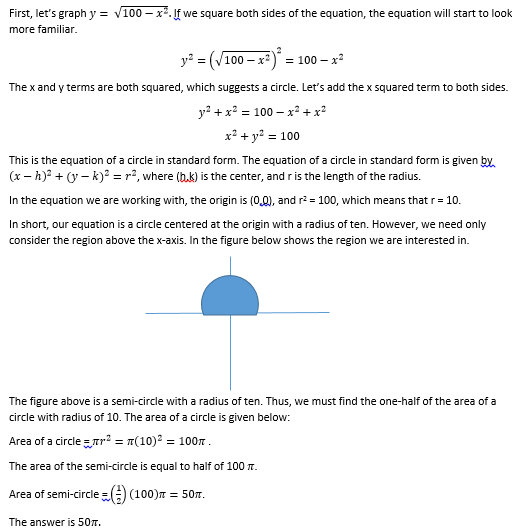Circles
Help Questions
PSAT Math › Circles
A square with a side length of 4 inches is inscribed in a circle, as shown below. What is the area of the unshaded region inside of the circle, in square inches?

8π - 16
4π-4
8π-4
2π-4
8π-8
Explanation
Using the Pythagorean Theorem, the diameter of the circle (also the diagonal of the square) can be found to be 4√2. Thus, the radius of the circle is half of the diameter, or 2√2. The area of the circle is then π(2√2)2, which equals 8π. Next, the area of the square must be subtracted from the entire circle, yielding an area of 8π-16 square inches.
100_π_
50_π_
25_π_
10_π_
20_π_
Explanation
100_π_
50_π_
25_π_
10_π_
20_π_
Explanation
A square with a side length of 4 inches is inscribed in a circle, as shown below. What is the area of the unshaded region inside of the circle, in square inches?

8π - 16
4π-4
8π-4
2π-4
8π-8
Explanation
Using the Pythagorean Theorem, the diameter of the circle (also the diagonal of the square) can be found to be 4√2. Thus, the radius of the circle is half of the diameter, or 2√2. The area of the circle is then π(2√2)2, which equals 8π. Next, the area of the square must be subtracted from the entire circle, yielding an area of 8π-16 square inches.
A square with a side length of 4 inches is inscribed in a circle, as shown below. What is the area of the unshaded region inside of the circle, in square inches?

8π - 16
4π-4
8π-4
2π-4
8π-8
Explanation
Using the Pythagorean Theorem, the diameter of the circle (also the diagonal of the square) can be found to be 4√2. Thus, the radius of the circle is half of the diameter, or 2√2. The area of the circle is then π(2√2)2, which equals 8π. Next, the area of the square must be subtracted from the entire circle, yielding an area of 8π-16 square inches.
100_π_
50_π_
25_π_
10_π_
20_π_
Explanation
What is the measure, in degrees, of the acute angle formed by the hands of a 12-hour clock that reads exactly 3:10?
35°
55°
60°
65°
72°
Explanation
The entire clock measures 360°. As the clock is divided into 12 sections, the distance between each number is equivalent to 30° (360/12). The distance between the 2 and the 3 on the clock is 30°. One has to account, however, for the 10 minutes that have passed. 10 minutes is 1/6 of an hour so the hour hand has also moved 1/6 of the distance between the 3 and the 4, which adds 5° (1/6 of 30°). The total measure of the angle, therefore, is 35°.
In a large field, a circle with an area of 144_π_ square meters is drawn out. Starting at the center of the circle, a groundskeeper mows in a straight line to the circle's edge. He then turns and mows ¼ of the way around the circle before turning again and mowing another straight line back to the center. What is the length, in meters, of the path the groundskeeper mowed?
24_π_
12 + 6_π_
12 + 36_π_
24 + 6_π_
24 + 36_π_
Explanation
Circles have an area of πr_2, where r is the radius. If this circle has an area of 144_π, then you can solve for the radius:
πr_2 = 144_π
r 2 = 144
r =12
When the groundskeeper goes from the center of the circle to the edge, he's creating a radius, which is 12 meters.
When he travels ¼ of the way around the circle, he's traveling ¼ of the circle's circumference. A circumference is 2_πr_. For this circle, that's 24_π_ meters. One-fourth of that is 6_π_ meters.
Finally, when he goes back to the center, he's creating another radius, which is 12 meters.
In all, that's 12 meters + 6_π_ meters + 12 meters, for a total of 24 + 6_π_ meters.
What is the measure, in degrees, of the acute angle formed by the hands of a 12-hour clock that reads exactly 3:10?
35°
55°
60°
65°
72°
Explanation
The entire clock measures 360°. As the clock is divided into 12 sections, the distance between each number is equivalent to 30° (360/12). The distance between the 2 and the 3 on the clock is 30°. One has to account, however, for the 10 minutes that have passed. 10 minutes is 1/6 of an hour so the hour hand has also moved 1/6 of the distance between the 3 and the 4, which adds 5° (1/6 of 30°). The total measure of the angle, therefore, is 35°.
In a large field, a circle with an area of 144_π_ square meters is drawn out. Starting at the center of the circle, a groundskeeper mows in a straight line to the circle's edge. He then turns and mows ¼ of the way around the circle before turning again and mowing another straight line back to the center. What is the length, in meters, of the path the groundskeeper mowed?
24_π_
12 + 6_π_
12 + 36_π_
24 + 6_π_
24 + 36_π_
Explanation
Circles have an area of πr_2, where r is the radius. If this circle has an area of 144_π, then you can solve for the radius:
πr_2 = 144_π
r 2 = 144
r =12
When the groundskeeper goes from the center of the circle to the edge, he's creating a radius, which is 12 meters.
When he travels ¼ of the way around the circle, he's traveling ¼ of the circle's circumference. A circumference is 2_πr_. For this circle, that's 24_π_ meters. One-fourth of that is 6_π_ meters.
Finally, when he goes back to the center, he's creating another radius, which is 12 meters.
In all, that's 12 meters + 6_π_ meters + 12 meters, for a total of 24 + 6_π_ meters.

